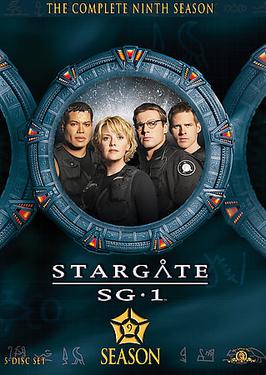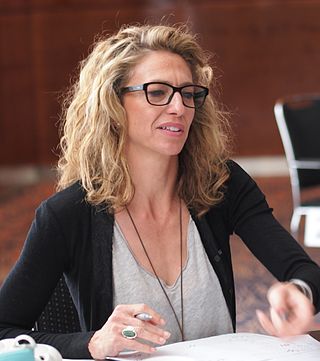
The red-eye effect in photography is the common appearance of red pupils in color photographs of the eyes of humans and several other animals. It occurs when using a photographic flash that is very close to the camera lens in ambient low light.

Stargate is a 1994 science fiction action adventure film directed and co-written by Roland Emmerich. The film is the first entry in the Stargate media franchise and stars Kurt Russell, James Spader, Jaye Davidson, Alexis Cruz, Mili Avital, and Viveca Lindfors. The plot centers on the premise of a "Stargate", an ancient ring-shaped device that creates a wormhole, enabling travel to a similar device elsewhere in the universe. The film's central plot explores the theory of extraterrestrial beings having an influence upon human civilization.

Chroma key compositing, or chroma keying, is a visual-effects and post-production technique for compositing (layering) two or more images or video streams together based on colour hues. The technique has been used in many fields to remove a background from the subject of a photo or video – particularly the newscasting, motion picture, and video game industries. A colour range in the foreground footage is made transparent, allowing separately filmed background footage or a static image to be inserted into the scene. The chroma keying technique is commonly used in video production and post-production. This technique is also referred to as colour keying, colour-separation overlay, or by various terms for specific colour-related variants such as green screen or blue screen; chroma keying can be done with backgrounds of any colour that are uniform and distinct, but green and blue backgrounds are more commonly used because they differ most distinctly in hue from any human skin colour. No part of the subject being filmed or photographed may duplicate the colour used as the backing, or the part may be erroneously identified as part of the backing.
A sleeper ship is a hypothetical type of crewed spacecraft, or starship in which most or all of the crew spend the journey in some form of hibernation or suspended animation. The only known technology that allows long-term suspended animation of humans is the freezing of early-stage human embryos through embryo cryopreservation, which is behind the concept of embryo space colonization.
Stargate Atlantis is an adventure and military science fiction television series and part of MGM's Stargate franchise. The show was created by Brad Wright and Robert C. Cooper as a spin-off series of Stargate SG-1, which was created by Wright and Jonathan Glassner and was itself based on the feature film Stargate (1994). All five seasons of Stargate Atlantis were broadcast by the Sci-Fi Channel in the United States and The Movie Network in Canada. The show premiered on July 16, 2004; its final episode aired on January 9, 2009. The series was filmed in and around Vancouver, British Columbia, Canada.

Prometheus or X-303 and later BC-303 is a fictional starship that appears in the military science fiction television series Stargate SG-1. The ship was first introduced during the shows sixth season in the episode titled "Prometheus", and would go on to become a recurring setting over the remainder of the series as well as being depicted in various spin-off media.

A Stargate is a fictional Einstein–Rosen bridge portal device within the Stargate fictional universe that allows practical, rapid travel between two distant locations. The devices first appeared in the 1994 Roland Emmerich film Stargate, and thereafter in the television series Stargate SG-1, Stargate Atlantis, and Stargate Universe. In these productions, the Stargate functions as a plot device, allowing the main characters to visit alien planets without the need for spaceships or any other type of technology. The device allows for near-instantaneous travel across both interstellar and extragalactic distances.

"Children of the Gods" is the first episode of the military science fiction television series Stargate SG-1. It was written by producers Jonathan Glassner and Brad Wright and was directed by Mario Azzopardi. The episode first aired on July 27, 1997, on Showtime. Originally presented as a television movie, the episode would later be split into two parts for repeats and syndicated viewings. A new, updated cut, which is entitled "Children of the Gods – The Final Cut" was released on DVD on July 21, 2009 by MGM Home Entertainment.
A theatrical cue is the trigger for an action to be carried out at a specific time. It is generally associated with theatre and the film industry. They can be necessary for a lighting change or effect, a sound effect, or some sort of stage or set movement/change.

The key light is the first and usually most important light that a photographer, cinematographer, lighting cameraman, or other scene composer will use in a lighting setup. The purpose of the key light is to highlight the form and dimension of the subject. The key light is not a rigid requirement; omitting the key light can result in a silhouette effect. Many key lights may be placed in a scene to illuminate a moving subject at opportune moments.

"Small Victories" is the first episode from season four of the science fiction television series Stargate SG-1. Penned by Robert C. Cooper and directed by Martin Wood, the episode first aired on the American subscription channel Showtime on June 30, 2000. "Small Victories" resumes the story of the season 3 finale, "Nemesis", in which the SG-1 team encountered the Replicators for the first time. As the Replicators threaten Earth and the Asgard home galaxy, the team must split to master their job.

In lighting design, backlighting is the process of illuminating the subject from the back. In other words, the lighting instrument and the viewer face each other, with the subject in between. This creates a glowing effect on the edges of the subject, while other areas are darker. The backlight can be a natural or artificial source of light. When artificial, the back light is usually placed directly behind the subject in a 4-point lighting setup. A back light, which lights foreground elements from the rear, is not to be confused with a background light, which lights background elements.
The technical rehearsal or tech rehearsal is a rehearsal that focuses on the technological aspects of the performance, in theatrical, musical, and filmed entertainment.

Stargate Universe is a military science fiction drama television series and part of MGM's Stargate franchise. It follows the adventures of a present-day, multinational exploration team traveling on the Ancient spaceship Destiny several billion light years distant from the Milky Way Galaxy. They are now trying to figure out a way to return to Earth, while simultaneously trying to explore and to survive in their unknown area of the universe. The series, created by Brad Wright and Robert C. Cooper, premiered in the United States on Syfy on October 2, 2009. The series featured an ensemble cast and was primarily filmed in and around Vancouver, British Columbia, Canada. A second season of 20 episodes was announced by Syfy in December 2009.
A beam projector is a lenseless stage lighting instrument with very little beam spread. It uses two reflectors. The primary reflector is a parabolic reflector and the secondary reflector is a spherical reflector. The parabolic reflector organizes the light into nearly parallel beams, and the spherical reflector is placed in front of the lamp to reflect light from the lamp back to the parabolic reflector, which reduces spill. The result is an intense shaft of light that cannot be easily controlled or modified. Beam projectors are often used to create a godspot effect. The beam projector no longer is used to the extent that it once was, as newer fixtures and PAR lamps have created easier ways to produce the effect. A similar effect can be produced using ETC Source Four PAR fixtures with a clear lens. A snoot/top hat can be added to control spill.

The ninth season of Stargate SG-1, an American-Canadian television series, began airing on July 15, 2005, on SCI FI. The ninth season concluded on March 10, 2006, after 20 episodes on the same channel. The series was originally developed by Brad Wright and Jonathan Glassner, and Brad Wright, Robert C. Cooper, Joseph Mallozzi and Paul Mullie served as executive producers. The season arc centers on the new threat of the Ori, a race who Daniel Jackson and Vala Mal Doran unleash in an unknown galaxy, and who are threatening to prepare for a crusade into the Milky Way galaxy to convert the beings to their religion called Origin.

The eighth season of Stargate SG-1, an American-Canadian military science fiction television series, began airing on July 9, 2004, on the Sci Fi channel. The eighth season concluded on February 22, 2005, after 20 episodes on British Sky One, which overtook the Sci Fi Channel in mid-season. This was the first season of the show to have 20 episodes instead of 22, as well as the first to air concurrently with Stargate SG-1 spinoff series Stargate Atlantis. The series was originally developed by Brad Wright and Jonathan Glassner, while Brad Wright and Robert C. Cooper served as executive producers. Season eight regular cast members include Richard Dean Anderson, Amanda Tapping, Christopher Judge, and Michael Shanks

Claudia Lee Black is an Australian actress, best known for her portrayals of Aeryn Sun in Farscape, Vala Mal Doran in Stargate SG-1 and Sharon "Shazza" Montgomery in the film Pitch Black. She has had prominent roles in video games, such as Chloe Frazer in Uncharted, Morrigan in Dragon Age, Admiral Daro'Xen and Matriarch Aethyta in Mass Effect and Tess Everis in Destiny and Samantha Byrne in Gears of War 3, Gears of War 4, and Gears 5. She also had a recurring role as Dahlia in The Originals and starred as Dr. Sabine Lommers in TV series Containment.
This glossary of motion picture terms is a list of definitions of terms and concepts related to motion pictures, filmmaking, cinematography, and the film industry in general.













